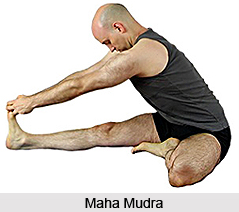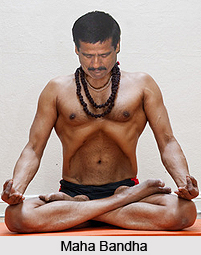
Mudras are an important part of Hatha Yoga because it helps to awaken the Goddess that is sleeping at the entrance of the Brahma Dwara or the great door. Hatha Yoga Pradipika has said that proper practise of Mudras annihilates old age and death. Mudras were given by Lord Shiva or Adinath. Mudras give eight kinds of wealth to the Yogi who practises them. Mudras should be kept a secret just as a box of jewellery is kept a secret or the dealings of husband and wife is kept a secret. Maha Mudra is practised by all wise Yogis and it is known as Mah Mudra because it has the capacity to destroy all evils and pains. Not only has that it also killed death. With both the nostrils the mudra should be practised and when on both sides it becomes equal then the Mudra should be stopped.
 The Maha Mudra is neither whole some or injurious as such but on the contrary it has the power to destroy all the chemicals or the rasas that is injurious to the body. Even the deadliest of poison gets destroyed with the help of the Mudras. Maha Mudra also has the capacity to destroy diseases like leprosy and diseases related to indigestion. The Maha Mudra also gives success or Siddhis to the Yogi who practises it and keeping it a secret from others enhances its effect.
The Maha Mudra is neither whole some or injurious as such but on the contrary it has the power to destroy all the chemicals or the rasas that is injurious to the body. Even the deadliest of poison gets destroyed with the help of the Mudras. Maha Mudra also has the capacity to destroy diseases like leprosy and diseases related to indigestion. The Maha Mudra also gives success or Siddhis to the Yogi who practises it and keeping it a secret from others enhances its effect.
The Maha Bandha a part of the Mudras also has the capacity to give Siddhas to the practitioner of that Mudra. Maha Veda is also known to be the destroyer of old age, diseases, death, increases appetite and confers the accomplishments of Anima.
Maha Mudra, Maha Bandha and Maha Veda are very essential and should be practised in a daily basis. Such Mudras increases the concentration of good actions within an individual and decreases the evil actions.
Hence it can be said that Mudras are very important in order to bring about balance of the mind and body. Rather it can be said that all evil actions are removed from the body and it becomes the abode of goodness.




















